ITECH 5500 Research Proposal on Privacy Concerns in Social Networking
VerifiedAdded on 2022/12/23
|14
|3646
|377
Project
AI Summary
This research proposal focuses on the growing privacy issues associated with social networking platforms like Facebook, Instagram, and Twitter. It highlights the potential for data security breaches and the negative impacts on both individuals and commercial organizations, including account hacking and impersonation. The proposal outlines the research questions, variables, and methodology, including the use of a descriptive research design and secondary data collection from peer-reviewed journals. Ethical considerations are addressed, and the potential impact of the findings is discussed. This document is available on Desklib, where students can find a wide range of past papers and solved assignments.
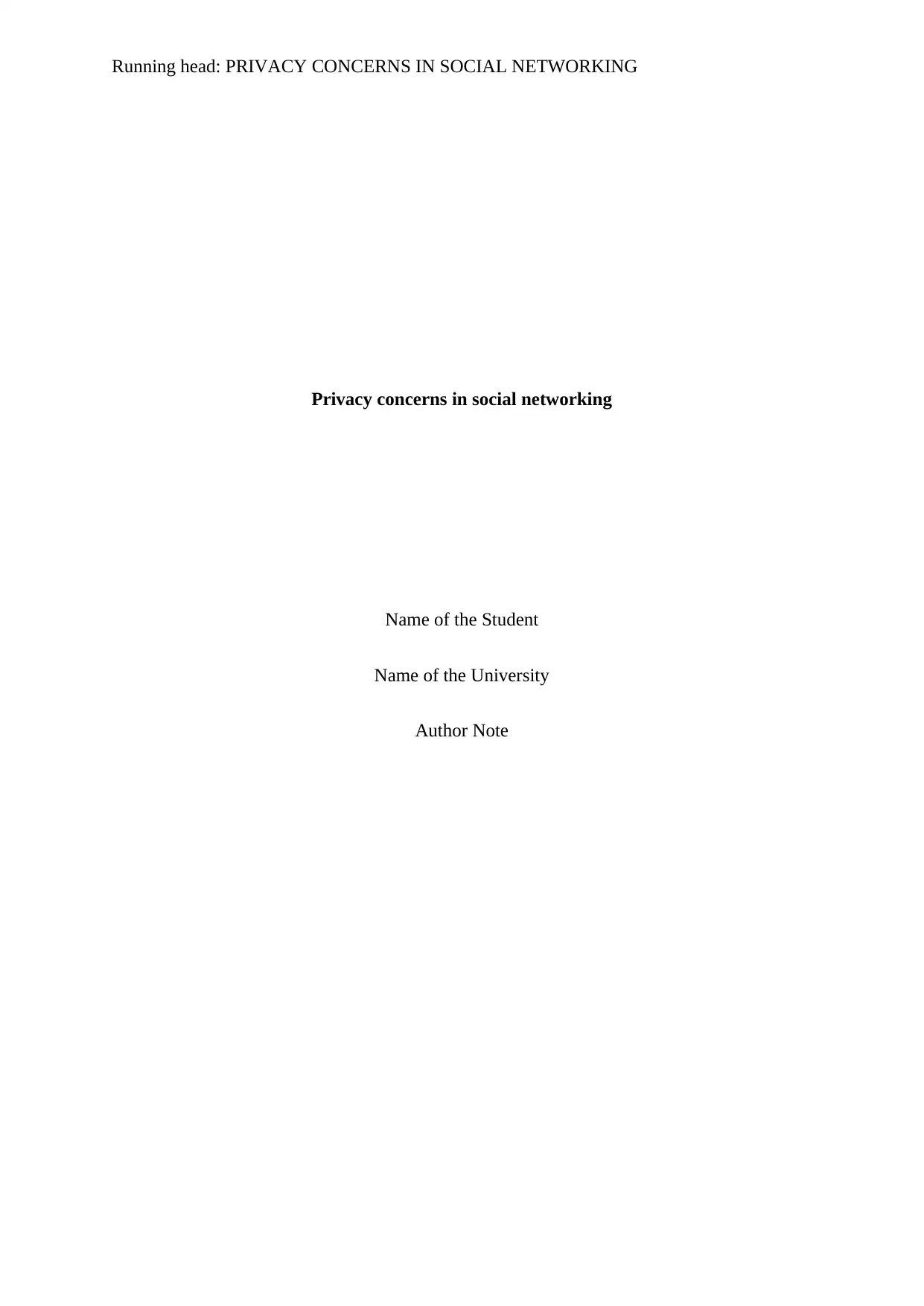
Running head: PRIVACY CONCERNS IN SOCIAL NETWORKING
Privacy concerns in social networking
Name of the Student
Name of the University
Author Note
Privacy concerns in social networking
Name of the Student
Name of the University
Author Note
Paraphrase This Document
Need a fresh take? Get an instant paraphrase of this document with our AI Paraphraser

1PRIVACY CONCERNS IN SOCIAL NETWORKING
Abstract
Privacy concerns have a huge impact for the users of different categories of social networking
platforms like Facebook, Whatsapp, Instagram, Snapchat. Each of these social networking
platforms are increasingly used both in our society as well as in global business
establishments and these privacy concerns usually leads to huge business loss and financial
loss in the commercial statements. Data security ids one of the prime concerns of the users as
a result of the privacy concerns in social networking. The enactment of each of the privacy
concerns shall be identified from different perspective in this proposal.
The findings of this proposal shall be entirely based on the data collection procedure and the
sampling procedure which will be conducted in an organized manner in this research. The
ethical considerations and the impact of the study can be understood from the findings of this
paper which will be entirely based on the data collection procedure.
Abstract
Privacy concerns have a huge impact for the users of different categories of social networking
platforms like Facebook, Whatsapp, Instagram, Snapchat. Each of these social networking
platforms are increasingly used both in our society as well as in global business
establishments and these privacy concerns usually leads to huge business loss and financial
loss in the commercial statements. Data security ids one of the prime concerns of the users as
a result of the privacy concerns in social networking. The enactment of each of the privacy
concerns shall be identified from different perspective in this proposal.
The findings of this proposal shall be entirely based on the data collection procedure and the
sampling procedure which will be conducted in an organized manner in this research. The
ethical considerations and the impact of the study can be understood from the findings of this
paper which will be entirely based on the data collection procedure.

2PRIVACY CONCERNS IN SOCIAL NETWORKING
Table of Contents
1. Introduction............................................................................................................................3
1.1 Research Background.......................................................................................................3
1.2 Purpose of the study.........................................................................................................3
1.3 Outline of the thesis.........................................................................................................3
1.4 Research questions...........................................................................................................4
1.5 Variables of this project...................................................................................................4
1.6 Problem description.........................................................................................................4
1.7 Structure of the paper.......................................................................................................4
2. Literature Review...................................................................................................................5
3. Methodology..........................................................................................................................6
3.1 Research design................................................................................................................6
3.2 Investigation type.............................................................................................................7
3.2 Variables of the project....................................................................................................7
3.3 Data collection method....................................................................................................7
3.5 Data analysis method.......................................................................................................9
4. Significance of ethical clearance..........................................................................................10
5.1 Findings of the proposal.....................................................................................................11
5.2 Impact on the field.............................................................................................................11
6. Conclusion............................................................................................................................11
7. Reference..............................................................................................................................13
Table of Contents
1. Introduction............................................................................................................................3
1.1 Research Background.......................................................................................................3
1.2 Purpose of the study.........................................................................................................3
1.3 Outline of the thesis.........................................................................................................3
1.4 Research questions...........................................................................................................4
1.5 Variables of this project...................................................................................................4
1.6 Problem description.........................................................................................................4
1.7 Structure of the paper.......................................................................................................4
2. Literature Review...................................................................................................................5
3. Methodology..........................................................................................................................6
3.1 Research design................................................................................................................6
3.2 Investigation type.............................................................................................................7
3.2 Variables of the project....................................................................................................7
3.3 Data collection method....................................................................................................7
3.5 Data analysis method.......................................................................................................9
4. Significance of ethical clearance..........................................................................................10
5.1 Findings of the proposal.....................................................................................................11
5.2 Impact on the field.............................................................................................................11
6. Conclusion............................................................................................................................11
7. Reference..............................................................................................................................13
⊘ This is a preview!⊘
Do you want full access?
Subscribe today to unlock all pages.

Trusted by 1+ million students worldwide

3PRIVACY CONCERNS IN SOCIAL NETWORKING
1. Introduction
The notable objective this proposal is to focus on the privacy issues of social
networking which is increasing at an alarming rate both in our society as well as in
commercial organizations.
1.1 Research Background
Numerous categories of social media platforms which are commonly deployed in our
society such as Facebook, Instagram, Twitter, and Snap chat. Each of these social media
channels have limitations in terms of the API issues which might be responsible for numerous
data security breaches (Peng, Wang & Xie 2016).The different categories of data access
methods which are used in these social media platforms in terms of searching the location of
the data which is accessible by each of these social media platforms if the location settings
are on the users.
1.2 Purpose of the study
This proposal shall be identifying each of the privacy concerns which are raised by
each of these social media platforms.
1.3 Outline of the thesis
The privacy concerns coming from each of the different categories of social media
platforms is having an adverse impact on our society as well as in commercial establishment.
Account hacking and impersonation are the two prime negative impact caused as a result of
the privacy concerns. Thus, this proposal shall be very much convenient to recognize the
different privacy issues and the reasons behind the privacy issues associated with the
different categories of social networking platforms. This proposal shall identify the variables
of the project and the findings of this proposal shall be depended on the basis of the chosen
1. Introduction
The notable objective this proposal is to focus on the privacy issues of social
networking which is increasing at an alarming rate both in our society as well as in
commercial organizations.
1.1 Research Background
Numerous categories of social media platforms which are commonly deployed in our
society such as Facebook, Instagram, Twitter, and Snap chat. Each of these social media
channels have limitations in terms of the API issues which might be responsible for numerous
data security breaches (Peng, Wang & Xie 2016).The different categories of data access
methods which are used in these social media platforms in terms of searching the location of
the data which is accessible by each of these social media platforms if the location settings
are on the users.
1.2 Purpose of the study
This proposal shall be identifying each of the privacy concerns which are raised by
each of these social media platforms.
1.3 Outline of the thesis
The privacy concerns coming from each of the different categories of social media
platforms is having an adverse impact on our society as well as in commercial establishment.
Account hacking and impersonation are the two prime negative impact caused as a result of
the privacy concerns. Thus, this proposal shall be very much convenient to recognize the
different privacy issues and the reasons behind the privacy issues associated with the
different categories of social networking platforms. This proposal shall identify the variables
of the project and the findings of this proposal shall be depended on the basis of the chosen
Paraphrase This Document
Need a fresh take? Get an instant paraphrase of this document with our AI Paraphraser

4PRIVACY CONCERNS IN SOCIAL NETWORKING
data collection procedure. The entire research design, data analysis and the ethical concerns
of this research shall be highlighted in this proposal.
1.4 Research questions
What are the impacts of the privacy issues of social networking?
Are users of social networking aware of privacy issues?
How can privacy issues of these platforms be contained?
1.5 Variables of this project
The dependent variable of the project is the use of social networking channels and the
independent variable of this project is the privacy issues associated with each of these social
media platforms. There is a direct relationship between each of these variables as the impact
of the independent variable can have a huge impact on the dependent variable.
1.6 Problem description
There are numerous ethical concerns associated with the deployment of social
networking platforms which are deployed in our society as well as the commercial
organizations. These ethical concerns usually occurs due to external factors such as provision
to the third parties and data security issues.
1.7 Structure of the paper
The introduction chapter of this proposal shall be followed by the literature review
where researchers of peer reviewed articles shall state their opinion about the privacy
concerns of social networking. The research approach, data collection, data analysis and
ethical concerns of this proposal shall be focussed on the later stages of this proposal. The
impact of the findings of this proposal shall also be identified after the research methodology
section.
data collection procedure. The entire research design, data analysis and the ethical concerns
of this research shall be highlighted in this proposal.
1.4 Research questions
What are the impacts of the privacy issues of social networking?
Are users of social networking aware of privacy issues?
How can privacy issues of these platforms be contained?
1.5 Variables of this project
The dependent variable of the project is the use of social networking channels and the
independent variable of this project is the privacy issues associated with each of these social
media platforms. There is a direct relationship between each of these variables as the impact
of the independent variable can have a huge impact on the dependent variable.
1.6 Problem description
There are numerous ethical concerns associated with the deployment of social
networking platforms which are deployed in our society as well as the commercial
organizations. These ethical concerns usually occurs due to external factors such as provision
to the third parties and data security issues.
1.7 Structure of the paper
The introduction chapter of this proposal shall be followed by the literature review
where researchers of peer reviewed articles shall state their opinion about the privacy
concerns of social networking. The research approach, data collection, data analysis and
ethical concerns of this proposal shall be focussed on the later stages of this proposal. The
impact of the findings of this proposal shall also be identified after the research methodology
section.
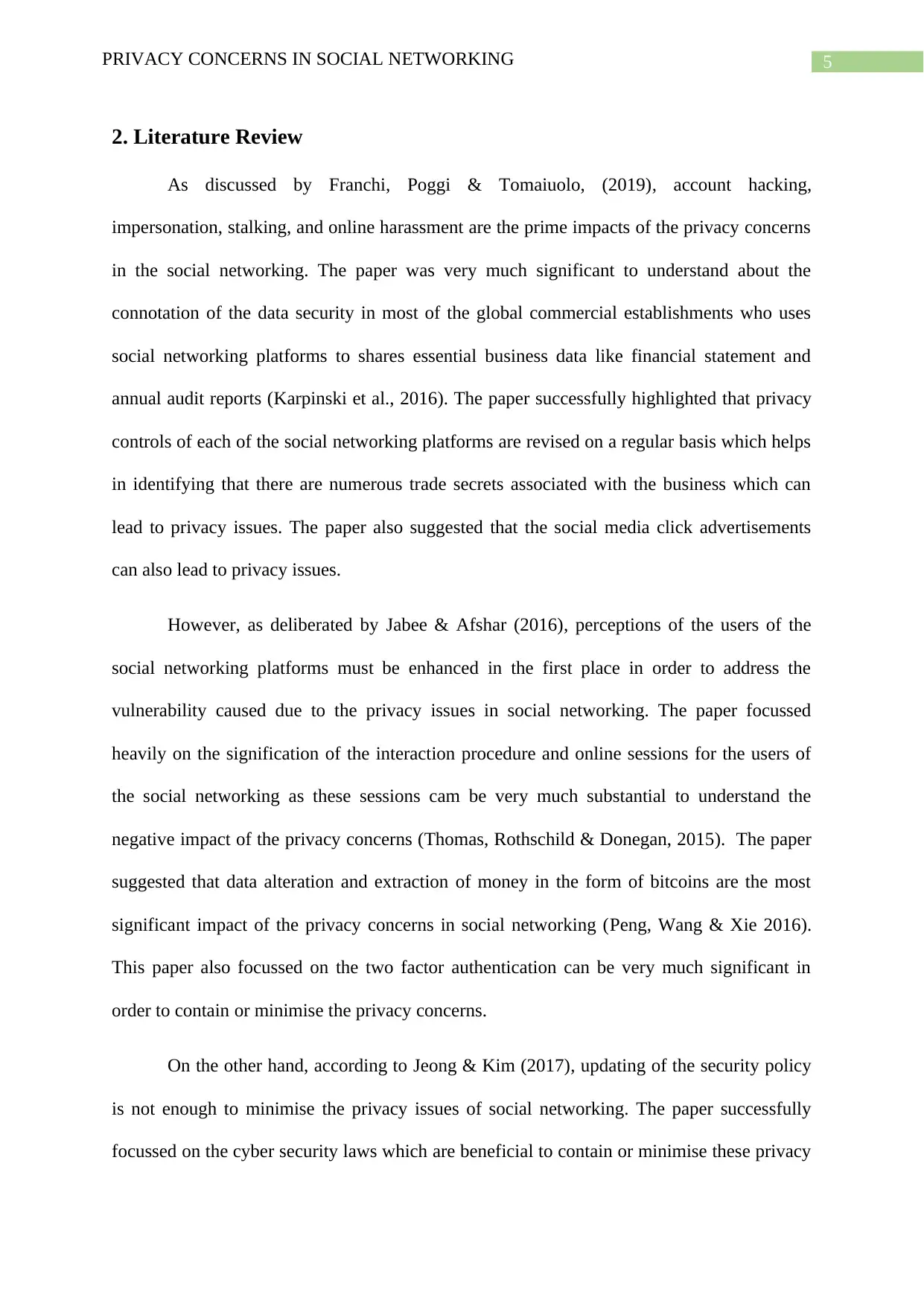
5PRIVACY CONCERNS IN SOCIAL NETWORKING
2. Literature Review
As discussed by Franchi, Poggi & Tomaiuolo, (2019), account hacking,
impersonation, stalking, and online harassment are the prime impacts of the privacy concerns
in the social networking. The paper was very much significant to understand about the
connotation of the data security in most of the global commercial establishments who uses
social networking platforms to shares essential business data like financial statement and
annual audit reports (Karpinski et al., 2016). The paper successfully highlighted that privacy
controls of each of the social networking platforms are revised on a regular basis which helps
in identifying that there are numerous trade secrets associated with the business which can
lead to privacy issues. The paper also suggested that the social media click advertisements
can also lead to privacy issues.
However, as deliberated by Jabee & Afshar (2016), perceptions of the users of the
social networking platforms must be enhanced in the first place in order to address the
vulnerability caused due to the privacy issues in social networking. The paper focussed
heavily on the signification of the interaction procedure and online sessions for the users of
the social networking as these sessions cam be very much substantial to understand the
negative impact of the privacy concerns (Thomas, Rothschild & Donegan, 2015). The paper
suggested that data alteration and extraction of money in the form of bitcoins are the most
significant impact of the privacy concerns in social networking (Peng, Wang & Xie 2016).
This paper also focussed on the two factor authentication can be very much significant in
order to contain or minimise the privacy concerns.
On the other hand, according to Jeong & Kim (2017), updating of the security policy
is not enough to minimise the privacy issues of social networking. The paper successfully
focussed on the cyber security laws which are beneficial to contain or minimise these privacy
2. Literature Review
As discussed by Franchi, Poggi & Tomaiuolo, (2019), account hacking,
impersonation, stalking, and online harassment are the prime impacts of the privacy concerns
in the social networking. The paper was very much significant to understand about the
connotation of the data security in most of the global commercial establishments who uses
social networking platforms to shares essential business data like financial statement and
annual audit reports (Karpinski et al., 2016). The paper successfully highlighted that privacy
controls of each of the social networking platforms are revised on a regular basis which helps
in identifying that there are numerous trade secrets associated with the business which can
lead to privacy issues. The paper also suggested that the social media click advertisements
can also lead to privacy issues.
However, as deliberated by Jabee & Afshar (2016), perceptions of the users of the
social networking platforms must be enhanced in the first place in order to address the
vulnerability caused due to the privacy issues in social networking. The paper focussed
heavily on the signification of the interaction procedure and online sessions for the users of
the social networking as these sessions cam be very much substantial to understand the
negative impact of the privacy concerns (Thomas, Rothschild & Donegan, 2015). The paper
suggested that data alteration and extraction of money in the form of bitcoins are the most
significant impact of the privacy concerns in social networking (Peng, Wang & Xie 2016).
This paper also focussed on the two factor authentication can be very much significant in
order to contain or minimise the privacy concerns.
On the other hand, according to Jeong & Kim (2017), updating of the security policy
is not enough to minimise the privacy issues of social networking. The paper successfully
focussed on the cyber security laws which are beneficial to contain or minimise these privacy
⊘ This is a preview!⊘
Do you want full access?
Subscribe today to unlock all pages.

Trusted by 1+ million students worldwide
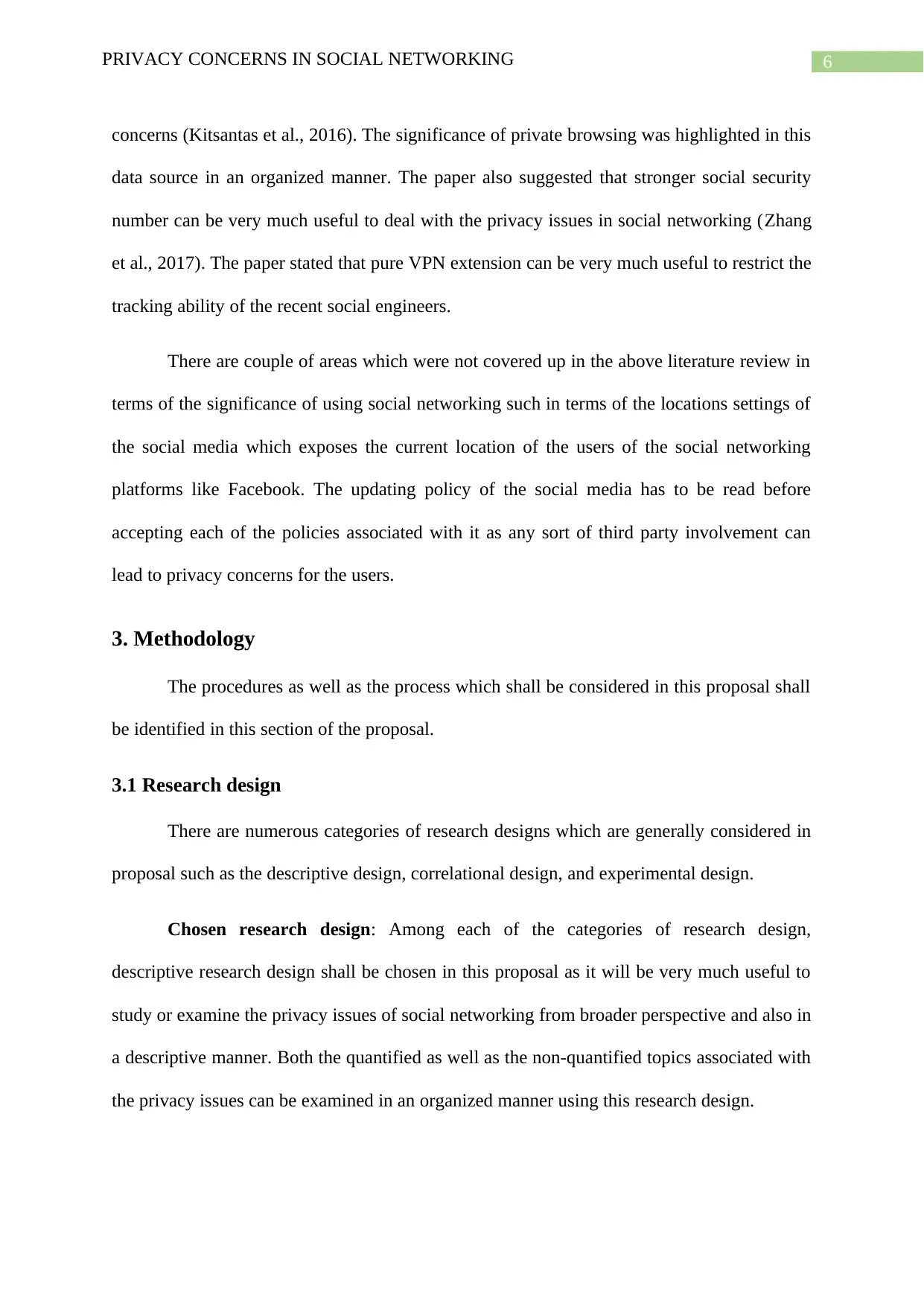
6PRIVACY CONCERNS IN SOCIAL NETWORKING
concerns (Kitsantas et al., 2016). The significance of private browsing was highlighted in this
data source in an organized manner. The paper also suggested that stronger social security
number can be very much useful to deal with the privacy issues in social networking (Zhang
et al., 2017). The paper stated that pure VPN extension can be very much useful to restrict the
tracking ability of the recent social engineers.
There are couple of areas which were not covered up in the above literature review in
terms of the significance of using social networking such in terms of the locations settings of
the social media which exposes the current location of the users of the social networking
platforms like Facebook. The updating policy of the social media has to be read before
accepting each of the policies associated with it as any sort of third party involvement can
lead to privacy concerns for the users.
3. Methodology
The procedures as well as the process which shall be considered in this proposal shall
be identified in this section of the proposal.
3.1 Research design
There are numerous categories of research designs which are generally considered in
proposal such as the descriptive design, correlational design, and experimental design.
Chosen research design: Among each of the categories of research design,
descriptive research design shall be chosen in this proposal as it will be very much useful to
study or examine the privacy issues of social networking from broader perspective and also in
a descriptive manner. Both the quantified as well as the non-quantified topics associated with
the privacy issues can be examined in an organized manner using this research design.
concerns (Kitsantas et al., 2016). The significance of private browsing was highlighted in this
data source in an organized manner. The paper also suggested that stronger social security
number can be very much useful to deal with the privacy issues in social networking (Zhang
et al., 2017). The paper stated that pure VPN extension can be very much useful to restrict the
tracking ability of the recent social engineers.
There are couple of areas which were not covered up in the above literature review in
terms of the significance of using social networking such in terms of the locations settings of
the social media which exposes the current location of the users of the social networking
platforms like Facebook. The updating policy of the social media has to be read before
accepting each of the policies associated with it as any sort of third party involvement can
lead to privacy concerns for the users.
3. Methodology
The procedures as well as the process which shall be considered in this proposal shall
be identified in this section of the proposal.
3.1 Research design
There are numerous categories of research designs which are generally considered in
proposal such as the descriptive design, correlational design, and experimental design.
Chosen research design: Among each of the categories of research design,
descriptive research design shall be chosen in this proposal as it will be very much useful to
study or examine the privacy issues of social networking from broader perspective and also in
a descriptive manner. Both the quantified as well as the non-quantified topics associated with
the privacy issues can be examined in an organized manner using this research design.
Paraphrase This Document
Need a fresh take? Get an instant paraphrase of this document with our AI Paraphraser
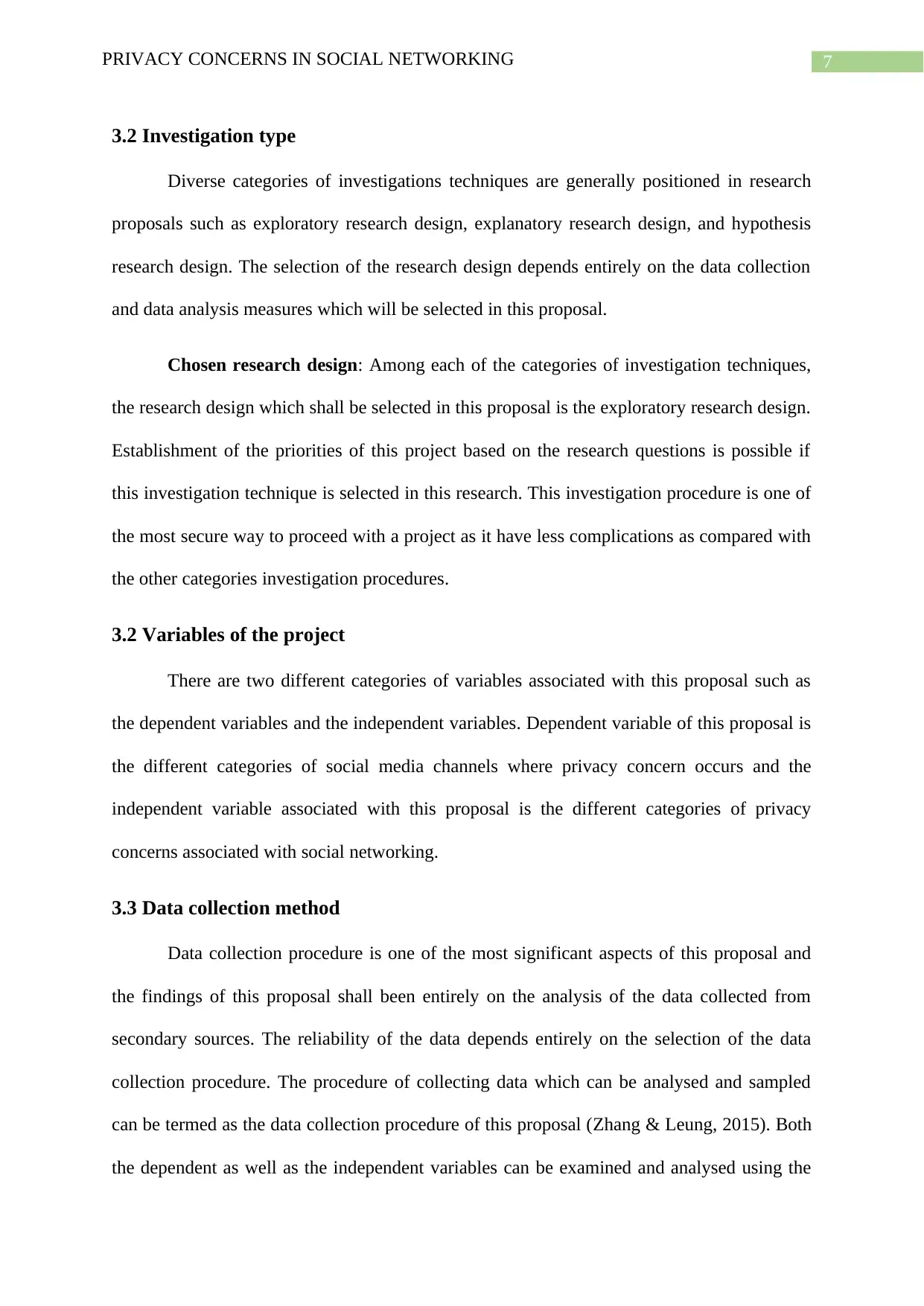
7PRIVACY CONCERNS IN SOCIAL NETWORKING
3.2 Investigation type
Diverse categories of investigations techniques are generally positioned in research
proposals such as exploratory research design, explanatory research design, and hypothesis
research design. The selection of the research design depends entirely on the data collection
and data analysis measures which will be selected in this proposal.
Chosen research design: Among each of the categories of investigation techniques,
the research design which shall be selected in this proposal is the exploratory research design.
Establishment of the priorities of this project based on the research questions is possible if
this investigation technique is selected in this research. This investigation procedure is one of
the most secure way to proceed with a project as it have less complications as compared with
the other categories investigation procedures.
3.2 Variables of the project
There are two different categories of variables associated with this proposal such as
the dependent variables and the independent variables. Dependent variable of this proposal is
the different categories of social media channels where privacy concern occurs and the
independent variable associated with this proposal is the different categories of privacy
concerns associated with social networking.
3.3 Data collection method
Data collection procedure is one of the most significant aspects of this proposal and
the findings of this proposal shall been entirely on the analysis of the data collected from
secondary sources. The reliability of the data depends entirely on the selection of the data
collection procedure. The procedure of collecting data which can be analysed and sampled
can be termed as the data collection procedure of this proposal (Zhang & Leung, 2015). Both
the dependent as well as the independent variables can be examined and analysed using the
3.2 Investigation type
Diverse categories of investigations techniques are generally positioned in research
proposals such as exploratory research design, explanatory research design, and hypothesis
research design. The selection of the research design depends entirely on the data collection
and data analysis measures which will be selected in this proposal.
Chosen research design: Among each of the categories of investigation techniques,
the research design which shall be selected in this proposal is the exploratory research design.
Establishment of the priorities of this project based on the research questions is possible if
this investigation technique is selected in this research. This investigation procedure is one of
the most secure way to proceed with a project as it have less complications as compared with
the other categories investigation procedures.
3.2 Variables of the project
There are two different categories of variables associated with this proposal such as
the dependent variables and the independent variables. Dependent variable of this proposal is
the different categories of social media channels where privacy concern occurs and the
independent variable associated with this proposal is the different categories of privacy
concerns associated with social networking.
3.3 Data collection method
Data collection procedure is one of the most significant aspects of this proposal and
the findings of this proposal shall been entirely on the analysis of the data collected from
secondary sources. The reliability of the data depends entirely on the selection of the data
collection procedure. The procedure of collecting data which can be analysed and sampled
can be termed as the data collection procedure of this proposal (Zhang & Leung, 2015). Both
the dependent as well as the independent variables can be examined and analysed using the
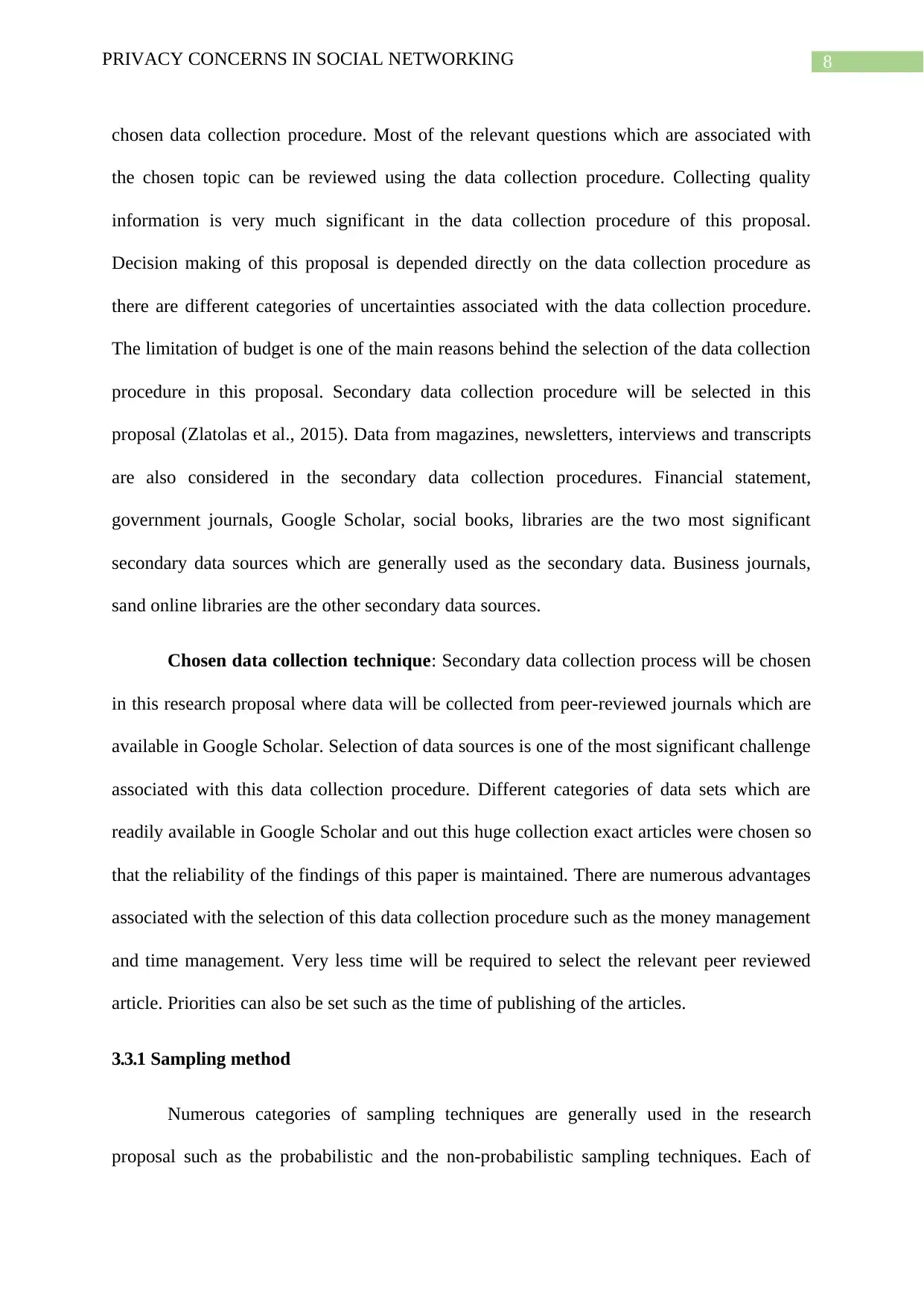
8PRIVACY CONCERNS IN SOCIAL NETWORKING
chosen data collection procedure. Most of the relevant questions which are associated with
the chosen topic can be reviewed using the data collection procedure. Collecting quality
information is very much significant in the data collection procedure of this proposal.
Decision making of this proposal is depended directly on the data collection procedure as
there are different categories of uncertainties associated with the data collection procedure.
The limitation of budget is one of the main reasons behind the selection of the data collection
procedure in this proposal. Secondary data collection procedure will be selected in this
proposal (Zlatolas et al., 2015). Data from magazines, newsletters, interviews and transcripts
are also considered in the secondary data collection procedures. Financial statement,
government journals, Google Scholar, social books, libraries are the two most significant
secondary data sources which are generally used as the secondary data. Business journals,
sand online libraries are the other secondary data sources.
Chosen data collection technique: Secondary data collection process will be chosen
in this research proposal where data will be collected from peer-reviewed journals which are
available in Google Scholar. Selection of data sources is one of the most significant challenge
associated with this data collection procedure. Different categories of data sets which are
readily available in Google Scholar and out this huge collection exact articles were chosen so
that the reliability of the findings of this paper is maintained. There are numerous advantages
associated with the selection of this data collection procedure such as the money management
and time management. Very less time will be required to select the relevant peer reviewed
article. Priorities can also be set such as the time of publishing of the articles.
3.3.1 Sampling method
Numerous categories of sampling techniques are generally used in the research
proposal such as the probabilistic and the non-probabilistic sampling techniques. Each of
chosen data collection procedure. Most of the relevant questions which are associated with
the chosen topic can be reviewed using the data collection procedure. Collecting quality
information is very much significant in the data collection procedure of this proposal.
Decision making of this proposal is depended directly on the data collection procedure as
there are different categories of uncertainties associated with the data collection procedure.
The limitation of budget is one of the main reasons behind the selection of the data collection
procedure in this proposal. Secondary data collection procedure will be selected in this
proposal (Zlatolas et al., 2015). Data from magazines, newsletters, interviews and transcripts
are also considered in the secondary data collection procedures. Financial statement,
government journals, Google Scholar, social books, libraries are the two most significant
secondary data sources which are generally used as the secondary data. Business journals,
sand online libraries are the other secondary data sources.
Chosen data collection technique: Secondary data collection process will be chosen
in this research proposal where data will be collected from peer-reviewed journals which are
available in Google Scholar. Selection of data sources is one of the most significant challenge
associated with this data collection procedure. Different categories of data sets which are
readily available in Google Scholar and out this huge collection exact articles were chosen so
that the reliability of the findings of this paper is maintained. There are numerous advantages
associated with the selection of this data collection procedure such as the money management
and time management. Very less time will be required to select the relevant peer reviewed
article. Priorities can also be set such as the time of publishing of the articles.
3.3.1 Sampling method
Numerous categories of sampling techniques are generally used in the research
proposal such as the probabilistic and the non-probabilistic sampling techniques. Each of
⊘ This is a preview!⊘
Do you want full access?
Subscribe today to unlock all pages.

Trusted by 1+ million students worldwide

9PRIVACY CONCERNS IN SOCIAL NETWORKING
these two categories of sampling techniques have their own advantages as well as limitations
which has to be considered during the planning phase of this proposal.
Probabilistic sampling method is generally used for the data which have mathematical
calculations associated with it. Probabilistic sampling can again be classified into numerous
categories such as the simple random sampling, and cluster random sampling. Non-
probabilistic sampling can be defined as the sampling procedure which samples data which
do not have any numerical calculations (Williams & Woodacre, 2016). There are different
categories of non-probabilistic sampling method which are deployed in the research proposal
such as purposive non probabilistic sampling, and snowball sampling.
Chosen sampling method: Non Probabilistic sampling method will be chosen as
there are no real mathematical calculations associated with the collected secondary data.
Among the non-probabilistic sampling methods, it can be said that purposive non
probabilistic sampling technique. Subjective judgements can be done using this non-
probabilistic sampling technique as well.
3.5 Data analysis method
Two categories of data analysis plans are generally deployed in the research proposals
such as the qualitative and the quantitative data analyses techniques. Selection of the data
analysis techniques depends entirely on the data collection procedure. The primary data
which are collected from primary sources are generally analysed using the qualitative data
analysis techniques whereas data from secondary sources are generally analysed using the
quantitative data analysis procedures (Yüksel, Küpçü & Özkasap, 2017). Protection of data
after the analysis is very much significant in the research proposals and the selection of the
quantitative data analysis techniques is very much significant in order to sustain the reliability
and the consistency of the data.
these two categories of sampling techniques have their own advantages as well as limitations
which has to be considered during the planning phase of this proposal.
Probabilistic sampling method is generally used for the data which have mathematical
calculations associated with it. Probabilistic sampling can again be classified into numerous
categories such as the simple random sampling, and cluster random sampling. Non-
probabilistic sampling can be defined as the sampling procedure which samples data which
do not have any numerical calculations (Williams & Woodacre, 2016). There are different
categories of non-probabilistic sampling method which are deployed in the research proposal
such as purposive non probabilistic sampling, and snowball sampling.
Chosen sampling method: Non Probabilistic sampling method will be chosen as
there are no real mathematical calculations associated with the collected secondary data.
Among the non-probabilistic sampling methods, it can be said that purposive non
probabilistic sampling technique. Subjective judgements can be done using this non-
probabilistic sampling technique as well.
3.5 Data analysis method
Two categories of data analysis plans are generally deployed in the research proposals
such as the qualitative and the quantitative data analyses techniques. Selection of the data
analysis techniques depends entirely on the data collection procedure. The primary data
which are collected from primary sources are generally analysed using the qualitative data
analysis techniques whereas data from secondary sources are generally analysed using the
quantitative data analysis procedures (Yüksel, Küpçü & Özkasap, 2017). Protection of data
after the analysis is very much significant in the research proposals and the selection of the
quantitative data analysis techniques is very much significant in order to sustain the reliability
and the consistency of the data.
Paraphrase This Document
Need a fresh take? Get an instant paraphrase of this document with our AI Paraphraser
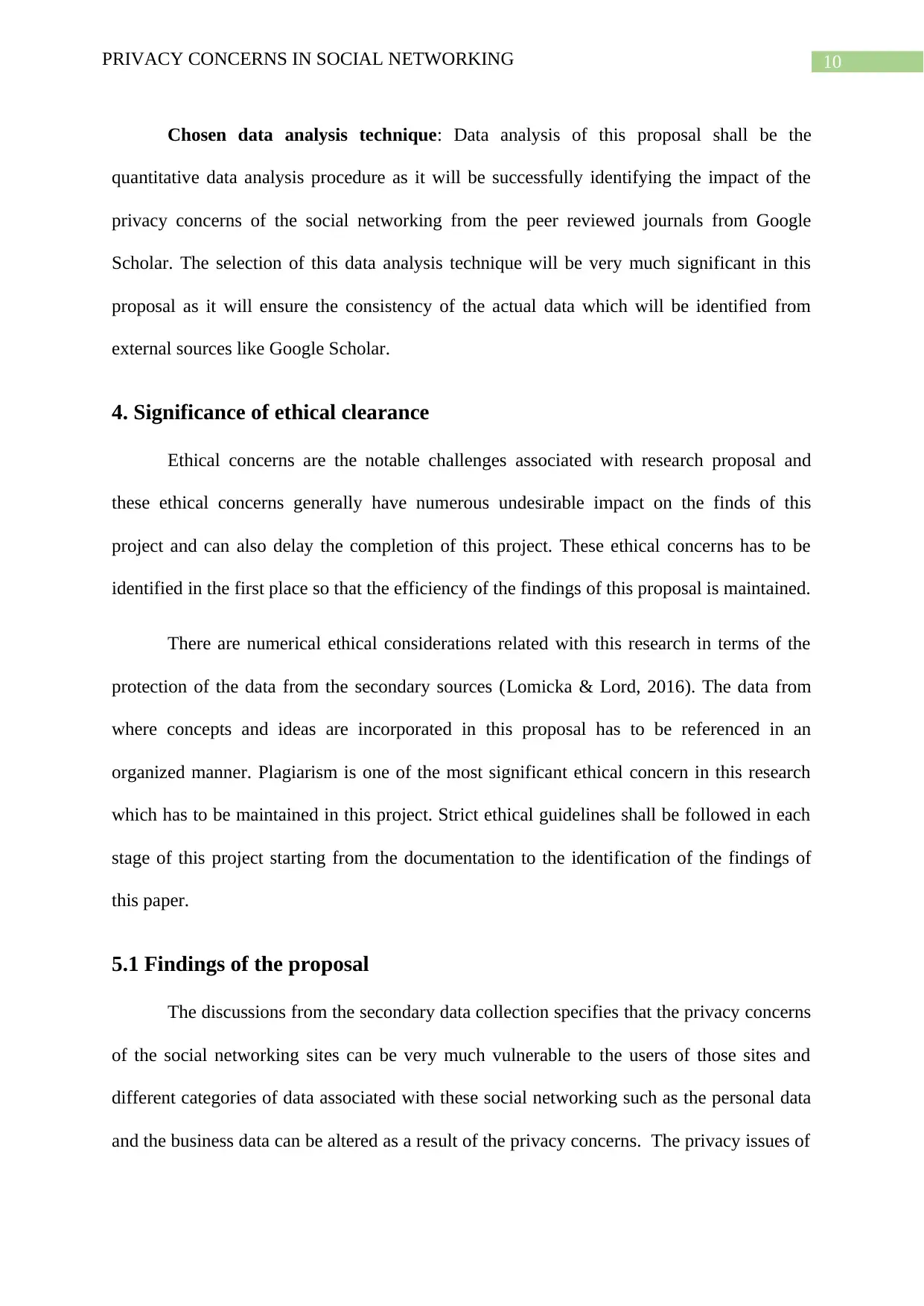
10PRIVACY CONCERNS IN SOCIAL NETWORKING
Chosen data analysis technique: Data analysis of this proposal shall be the
quantitative data analysis procedure as it will be successfully identifying the impact of the
privacy concerns of the social networking from the peer reviewed journals from Google
Scholar. The selection of this data analysis technique will be very much significant in this
proposal as it will ensure the consistency of the actual data which will be identified from
external sources like Google Scholar.
4. Significance of ethical clearance
Ethical concerns are the notable challenges associated with research proposal and
these ethical concerns generally have numerous undesirable impact on the finds of this
project and can also delay the completion of this project. These ethical concerns has to be
identified in the first place so that the efficiency of the findings of this proposal is maintained.
There are numerical ethical considerations related with this research in terms of the
protection of the data from the secondary sources (Lomicka & Lord, 2016). The data from
where concepts and ideas are incorporated in this proposal has to be referenced in an
organized manner. Plagiarism is one of the most significant ethical concern in this research
which has to be maintained in this project. Strict ethical guidelines shall be followed in each
stage of this project starting from the documentation to the identification of the findings of
this paper.
5.1 Findings of the proposal
The discussions from the secondary data collection specifies that the privacy concerns
of the social networking sites can be very much vulnerable to the users of those sites and
different categories of data associated with these social networking such as the personal data
and the business data can be altered as a result of the privacy concerns. The privacy issues of
Chosen data analysis technique: Data analysis of this proposal shall be the
quantitative data analysis procedure as it will be successfully identifying the impact of the
privacy concerns of the social networking from the peer reviewed journals from Google
Scholar. The selection of this data analysis technique will be very much significant in this
proposal as it will ensure the consistency of the actual data which will be identified from
external sources like Google Scholar.
4. Significance of ethical clearance
Ethical concerns are the notable challenges associated with research proposal and
these ethical concerns generally have numerous undesirable impact on the finds of this
project and can also delay the completion of this project. These ethical concerns has to be
identified in the first place so that the efficiency of the findings of this proposal is maintained.
There are numerical ethical considerations related with this research in terms of the
protection of the data from the secondary sources (Lomicka & Lord, 2016). The data from
where concepts and ideas are incorporated in this proposal has to be referenced in an
organized manner. Plagiarism is one of the most significant ethical concern in this research
which has to be maintained in this project. Strict ethical guidelines shall be followed in each
stage of this project starting from the documentation to the identification of the findings of
this paper.
5.1 Findings of the proposal
The discussions from the secondary data collection specifies that the privacy concerns
of the social networking sites can be very much vulnerable to the users of those sites and
different categories of data associated with these social networking such as the personal data
and the business data can be altered as a result of the privacy concerns. The privacy issues of
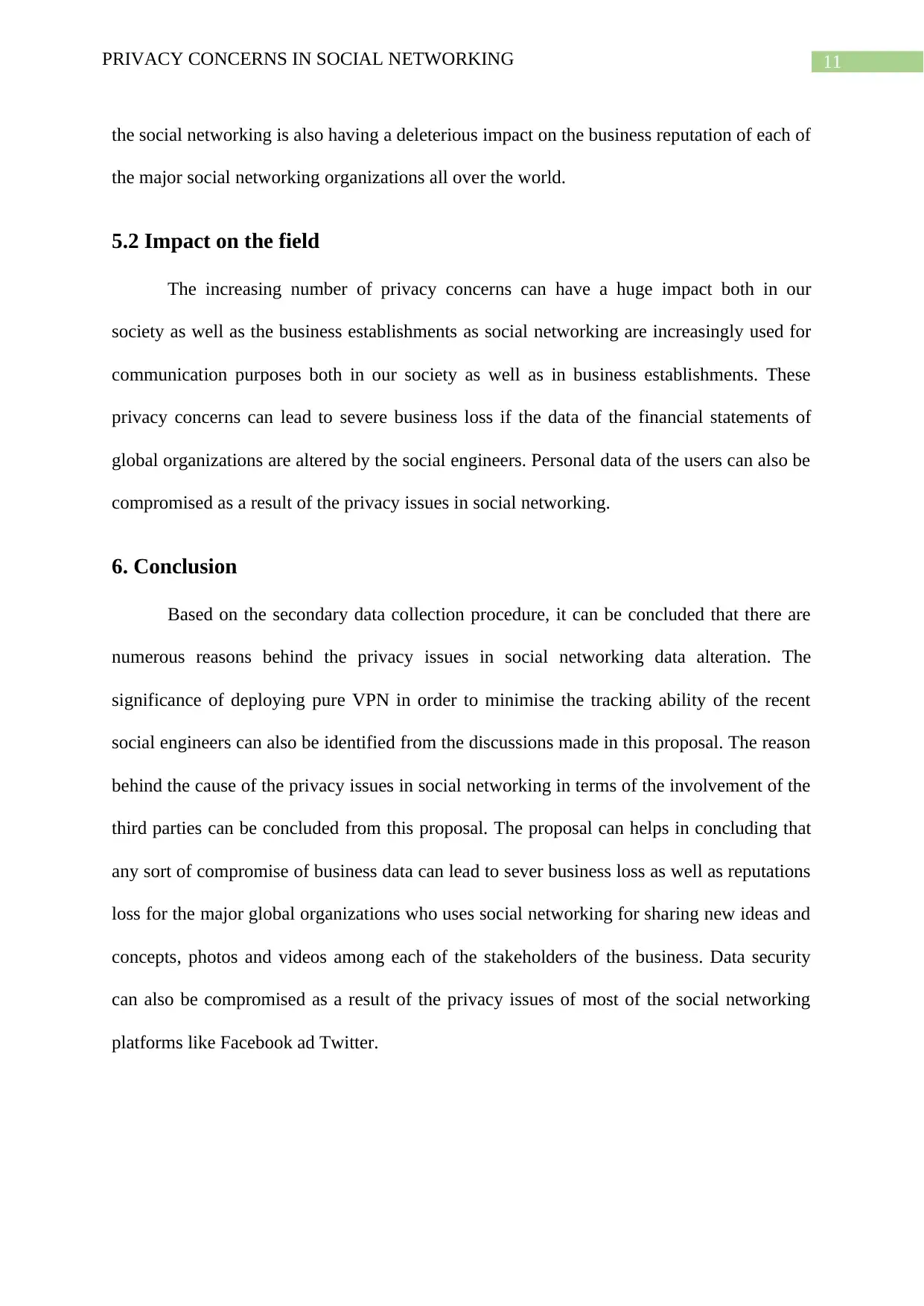
11PRIVACY CONCERNS IN SOCIAL NETWORKING
the social networking is also having a deleterious impact on the business reputation of each of
the major social networking organizations all over the world.
5.2 Impact on the field
The increasing number of privacy concerns can have a huge impact both in our
society as well as the business establishments as social networking are increasingly used for
communication purposes both in our society as well as in business establishments. These
privacy concerns can lead to severe business loss if the data of the financial statements of
global organizations are altered by the social engineers. Personal data of the users can also be
compromised as a result of the privacy issues in social networking.
6. Conclusion
Based on the secondary data collection procedure, it can be concluded that there are
numerous reasons behind the privacy issues in social networking data alteration. The
significance of deploying pure VPN in order to minimise the tracking ability of the recent
social engineers can also be identified from the discussions made in this proposal. The reason
behind the cause of the privacy issues in social networking in terms of the involvement of the
third parties can be concluded from this proposal. The proposal can helps in concluding that
any sort of compromise of business data can lead to sever business loss as well as reputations
loss for the major global organizations who uses social networking for sharing new ideas and
concepts, photos and videos among each of the stakeholders of the business. Data security
can also be compromised as a result of the privacy issues of most of the social networking
platforms like Facebook ad Twitter.
the social networking is also having a deleterious impact on the business reputation of each of
the major social networking organizations all over the world.
5.2 Impact on the field
The increasing number of privacy concerns can have a huge impact both in our
society as well as the business establishments as social networking are increasingly used for
communication purposes both in our society as well as in business establishments. These
privacy concerns can lead to severe business loss if the data of the financial statements of
global organizations are altered by the social engineers. Personal data of the users can also be
compromised as a result of the privacy issues in social networking.
6. Conclusion
Based on the secondary data collection procedure, it can be concluded that there are
numerous reasons behind the privacy issues in social networking data alteration. The
significance of deploying pure VPN in order to minimise the tracking ability of the recent
social engineers can also be identified from the discussions made in this proposal. The reason
behind the cause of the privacy issues in social networking in terms of the involvement of the
third parties can be concluded from this proposal. The proposal can helps in concluding that
any sort of compromise of business data can lead to sever business loss as well as reputations
loss for the major global organizations who uses social networking for sharing new ideas and
concepts, photos and videos among each of the stakeholders of the business. Data security
can also be compromised as a result of the privacy issues of most of the social networking
platforms like Facebook ad Twitter.
⊘ This is a preview!⊘
Do you want full access?
Subscribe today to unlock all pages.

Trusted by 1+ million students worldwide
1 out of 14
Related Documents
Your All-in-One AI-Powered Toolkit for Academic Success.
+13062052269
info@desklib.com
Available 24*7 on WhatsApp / Email
![[object Object]](/_next/static/media/star-bottom.7253800d.svg)
Unlock your academic potential
Copyright © 2020–2025 A2Z Services. All Rights Reserved. Developed and managed by ZUCOL.




